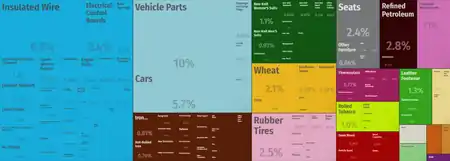
Romania has a complex, high-income market economy, the 45th largest in the world by total nominal GDP and the 36th largest based on purchasing power parity.[1] The country is a regional leader in multiple fields, such as IT and motor vehicle production.[2][3]
In 2016, Romania was the 46th largest exporter of goods in the world.[4]
In 2015, Romania's largest trading partner was Germany, followed by Italy. Romania's main exports to Germany were insulated wire, cars and vehicle parts, whereas its main German imports are cars and vehicle parts. The principal Italian imports to Romania include hides, footwear parts, pharmaceuticals, telephones, and vehicle parts. Romania's chief exports to Italy included leather footwear, cars, telephones, tobacco, men's suits, seats and iron pipes.[5]
2.8% of the country's GDP is derived from agricultural activity. While Romania imports substantial quantities of grain, it is largely self-sufficient in other agricultural products and food stuffs. Food must be regulated for sale in the retail market, therefore Romania imports almost no food products from other countries. In 2006 Romania imported food products worth €2.4 billion, up almost 20% versus 2005, when imports were worth slightly more than €2 billion. The European Union is Romania's main trade partner in agri-food products. Romanian EU exports represent 64%, and imports from EU countries represent 54%. Other important partners are the Central European Free Trade Agreement countries, Turkey, Moldova and the United States.[6]
Main export goods
The following is a list of the exports of Romania. Data is for 2017, in billions of United States dollars, as reported by The Observatory of Economic Complexity. Currently the top thirty exports are listed.[7]
| Rank | Product | Value ($ billion) |
|---|---|---|
| 1 | Vehicle parts | 7.09 |
| 2 | Insulated wire | 4.55 |
| 3 | Cars | 4.04 |
| 4 | Refined petroleum | 1.96 |
| 5 | Rubber tires | 1.79 |
| 6 | Seats | 1.72 |
| 7 | Electrical control boards | 1.69 |
| 8 | Wheat | 1.47 |
| 9 | Ball bearings | 0.942 |
| 10 | Low-voltage protective equipment | 0.941 |
| 11 | Electric heaters | 0.916 |
| 12 | Leather footwear | 0.899 |
| 13 | Packaged pharmaceuticals | 0.788 |
| 14 | Non-knit women's suits | 0.770 |
| 15 | Corn | 0.731 |
| 16 | Rolled tobacco | 0.729 |
| 17 | Liquid pumps | 0.718 |
| 18 | Electrical lighting and signalling equipment | 0.693 |
| 19 | Passenger and cargo ships | 0.673 |
| 20 | Air pumps | 0.666 |
| 21 | Non-knit men's suits | 0.655 |
| 22 | Spark-ignition engines | 0.643 |
| 23 | Sunflower seeds | 0.622 |
| 24 | Other furniture | 0.589 |
| 25 | Rapeseed | 0.581 |
| 26 | Iron pipes | 0.570 |
| 27 | Telephones | 0.549 |
| 28 | Thermostats | 0.546 |
| 29 | Sawn wood | 0.534 |
| 30 | Engine parts | 0.520 |
References
- ↑ https://desapublications.un.org/file/1098/download.
{{cite web}}: Missing or empty|title=(help) - ↑ Statistic definitions
- ↑ "BCR: Romania poate adopta euro in 2014 23904". Retrieved 16 September 2014.
- ↑ "Country Comparison: Exports". The World Factbook. Central Intelligence Agency. Archived from the original on 13 June 2007. Retrieved 18 February 2017.
- ↑ "Germany remains Romania's top trading partner. Which are the others?". romania-insider.com. 6 April 2016. Retrieved 24 June 2016.
- ↑ Romania imports agri-food products of 2.4 bn euros in 2006 – Danmarks ambassade Bukarest Archived 13 April 2008 at the Wayback Machine
- ↑ "What does Romania export?". Observatory of Economic Complexity. Retrieved 1 May 2017.